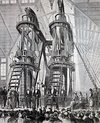Pedro II of Brazil
|
|

Dompedro-II.jpg
Dom Pedro II, Emperor of Brazil (December 2, 1825-December 5, 1891) was the second and final Brazilian Emperor. His name in full was Pedro de Alcântara João Carlos Leopoldo Salvador Bibiano Francisco Xavier de Paula Leocádio Miguel Rafael Gabriel Gonzaga, By the Grace of God and Unanimous Acclamation of the People, Constitutional Emperor and Perpetual Defender of Brazil.
He was born on December 2, 1825 in Rio de Janeiro, Brazil. When he was a boy of five, he became the emperor-to-be of Brazil on the edict of his father Pedro I who abdicated the throne on April 7, 1831 to fight a civil war in Portugal. The aim of the war in Portugal was to restore the throne of Portugal to Maria II, older sister of Pedro. As a result of caring for his children's interests, in 1834, the warrior father Pedro I had a daugher of 15 on the throne of Portugal and a son of 9 Pedro II who was emperor-to-be of Brazil. But until the boy emperor-to-be grew to be fifteen, a series of regents administered the government, as his father had commanded. And on July 18, 1841, the regents transferred full authority to the boy and crowned him Dom Pedro II, the Emperor of Brazil.
Dom Pedro II was married September 4, 1843 to Princess Teresa of the Two Sicilies (b. 1822 – d. 1889), the youngest daughter of King Francis I of the Two Sicilies (b. 1777 – d. 1830) and had four children:
- Alfons of Brazil (1874-1874)
- Isabella (Isabel), who married Louis Philippe Marie Ferdinand Gaston, comte d'Eu, son of Louis Charles Philippe Raphael, duc de Nemours.
- Leopoldine of Brasil (1847-1871), who married Prince August of Saxe-Coburg-Gotha.
- Peter Alfons of Brazil (1848-1850)
Dom Pedro II was in the United States during the Philadelphia Exposition of 1876, where Alexander Graham Bell showed him his new telephone. Pedro II probably was the first Brazilian to use the invention. He recited Shakespeare's classic line from Hamlet, "To be or not to be" into it, and exclaimed, "This thing speaks!".
Liberal in outlook, Pedro II took steps to industrialize Brazil and to end slavery. (The final abolition edict was signed in his absence by his daughter Princess Isabel, on May 13, 1888.) This progressive stance, however, brought him into conflict with the more conservative elements of Brazilian society. At the same time, the liberal elements, which he encouraged, eventually decided that Pedro was not willing to make reforms fast enough, so they also rejected his rule. Although Pedro was still popular among the people, he was deposed on November 15, 1889 by a military coup, and the imperial family was exiled.
DomPedroII.jpg
He died on December 5, 1891 in Paris, France. His and his wife's remains were brought to Brazil in 1922, and were reinterred in Petrópolis, their former summer residence, in 1939.
Books
- The Emperor's Beard: Dom Pedro II and His Tropical Monarchy in Brazil, Lilia Moritz Schwarcz (Author), John Gledson (Translator);Hill & Wang Pub; (February 10, 2003), ISBN 0809042193
See also
External links
- Historical Text Archive (http://historicaltextarchive.com/sections.php?op=viewarticle&artid=427)
- Brazilian Senate webpage (in Portuguese) (http://www.senado.gov.br/web/historia/decimas.htm)
| Preceded by: Pedro I | Emperor of Brazil | Succeeded by: Deodoro da Fonseca as President of Brazil and Isabel as Titular Empress of Brazil |
de:Peter II. (Brasilien) fr:Pierre II du Brésil nl:Peter II van Brazilië no:Pedro II av Brasil ja:ペドロ2世 pt:Pedro II do Brasil


